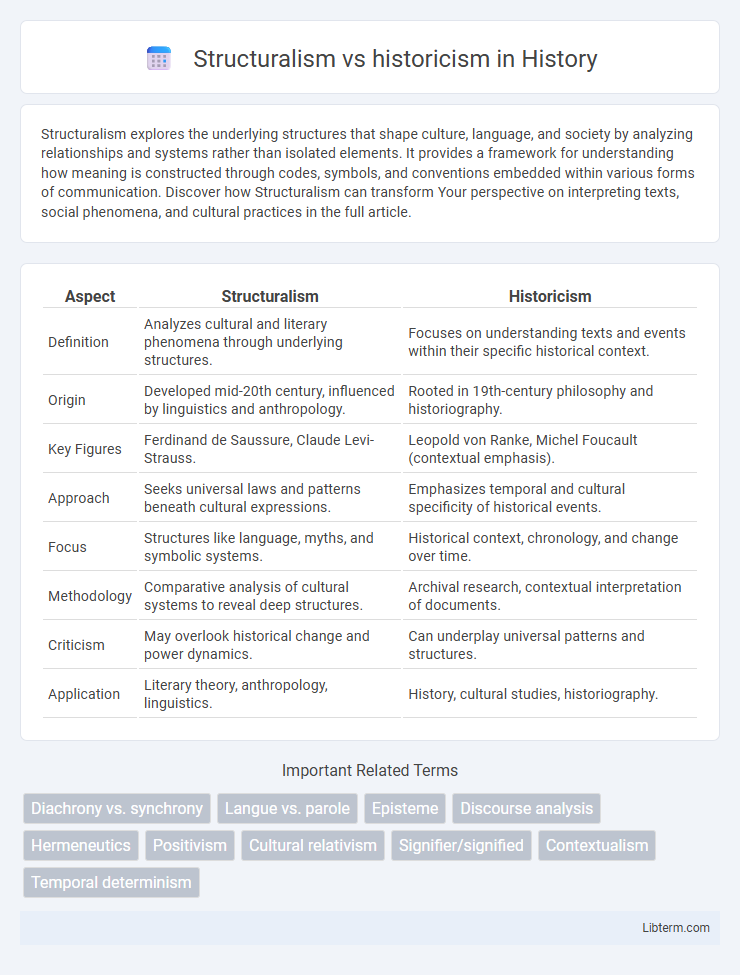Structuralism explores the underlying structures that shape culture, language, and society by analyzing relationships and systems rather than isolated elements. It provides a framework for understanding how meaning is constructed through codes, symbols, and conventions embedded within various forms of communication. Discover how Structuralism can transform Your perspective on interpreting texts, social phenomena, and cultural practices in the full article.
Table of Comparison
| Aspect | Structuralism | Historicism |
|---|---|---|
| Definition | Analyzes cultural and literary phenomena through underlying structures. | Focuses on understanding texts and events within their specific historical context. |
| Origin | Developed mid-20th century, influenced by linguistics and anthropology. | Rooted in 19th-century philosophy and historiography. |
| Key Figures | Ferdinand de Saussure, Claude Levi-Strauss. | Leopold von Ranke, Michel Foucault (contextual emphasis). |
| Approach | Seeks universal laws and patterns beneath cultural expressions. | Emphasizes temporal and cultural specificity of historical events. |
| Focus | Structures like language, myths, and symbolic systems. | Historical context, chronology, and change over time. |
| Methodology | Comparative analysis of cultural systems to reveal deep structures. | Archival research, contextual interpretation of documents. |
| Criticism | May overlook historical change and power dynamics. | Can underplay universal patterns and structures. |
| Application | Literary theory, anthropology, linguistics. | History, cultural studies, historiography. |
Introduction to Structuralism and Historicism
Structuralism examines literature through underlying systems and structures such as language, symbols, and cultural codes to uncover universal meanings. Historicism analyzes texts within their historical context, emphasizing the influence of social, political, and cultural conditions on literary works. Both approaches provide critical frameworks to interpret literature, with Structuralism focusing on internal structures and Historicism prioritizing external historical factors.
Core Principles of Structuralism
Structuralism centers on the idea that elements of human culture must be understood in terms of their relationship to a larger, overarching system or structure, emphasizing patterns and conventions that shape meaning. It highlights the role of unconscious structures underlying language, myths, and social phenomena, asserting that these structures determine human experience. The core principle involves analyzing binary oppositions and deep-seated rules that govern cultural expressions, rather than focusing on historical context or individual agency.
Fundamental Concepts of Historicism
Historicism centers on the fundamental concept that historical context shapes the meaning and interpretation of texts, emphasizing the temporal and cultural specificity inherent in all social and cultural phenomena. It argues that understanding the past requires viewing events within their unique historical framework, rejecting ahistorical or universalist interpretations. This approach prioritizes diachronic analysis, highlighting how historical conditions influence human thought and societal developments over time.
Key Proponents and Influential Figures
Structuralism's key proponents include Ferdinand de Saussure, who laid the foundation with his theory of language as a system of signs, and Claude Levi-Strauss, who applied structuralist methods to anthropology. In contrast, historicism is championed by scholars like Johann Gottfried Herder, emphasizing cultural and historical context, and Wilhelm Dilthey, who advocated understanding human experience through historical development. These figures shaped their respective movements by prioritizing either the underlying structures of meaning or the temporal, cultural particularities embedded in history.
Methodological Differences
Structuralism emphasizes the analysis of underlying structures, such as language, culture, or cognition, using systematic and synchronic methods to uncover universal patterns. Historicism prioritizes diachronic study, focusing on the contextual and temporal evolution of ideas, texts, or events within specific historical circumstances. Methodologically, structuralism relies on abstract models and binary oppositions, while historicism employs archival research and chronological contextualization to interpret meaning.
Structuralism in Literature and Cultural Studies
Structuralism in literature and cultural studies analyzes underlying systems such as language, narratives, and symbols that shape meaning within texts and cultural artifacts. It posits that meaning is generated through the relationships and differences within these structures rather than through individual elements or historical context. Key figures like Ferdinand de Saussure and Claude Levi-Strauss emphasize the role of binary oppositions and recurrent patterns in understanding cultural meaning across diverse societies.
Historicism’s Approach to Context and Meaning
Historicism emphasizes understanding literary works through their historical and cultural contexts, asserting that meaning is shaped by the time period and social conditions in which a text was produced. This approach prioritizes the influence of external factors such as political events, economic conditions, and prevailing ideologies on a text's interpretation. By situating a work within its original historical framework, historicism seeks to uncover layers of meaning that reveal the interconnectedness between literature and history.
Critiques and Debates: Structuralism vs Historicism
Critiques of Structuralism emphasize its tendency to overlook historical context and human agency by focusing solely on underlying systems and structures. Historicism is debated for its potential to fragment meaning through temporal specificity, sometimes neglecting universal patterns that Structuralism aims to reveal. The ongoing debate centers on whether cultural phenomena are best understood through timeless structures or through their historical evolution and contexts.
Applications in Modern Scholarship
Structuralism in modern scholarship analyzes underlying systems and patterns within cultural, linguistic, and literary texts, enabling researchers to decode abstract structures governing meaning. Historicism emphasizes the contextual analysis of texts and events, interpreting them through specific historical, social, and political conditions to understand their significance over time. Both approaches are applied across disciplines like literary criticism, anthropology, and cultural studies, where structuralism reveals universal frameworks and historicism situates phenomena within dynamic temporal contexts.
Conclusion: Comparative Insights and Future Directions
Structuralism and historicism offer complementary lenses for analyzing cultural phenomena, with structuralism emphasizing universal patterns and historicism focusing on contextual evolution. Both approaches reveal the dynamic interplay between underlying structures and historical contingencies, highlighting the necessity of integrating synchronic and diachronic methods in advanced research. Future directions involve interdisciplinary frameworks that leverage computational tools and cross-cultural comparisons to deepen understanding of how structures transform over time within specific historical contexts.
Structuralism Infographic

 libterm.com
libterm.com